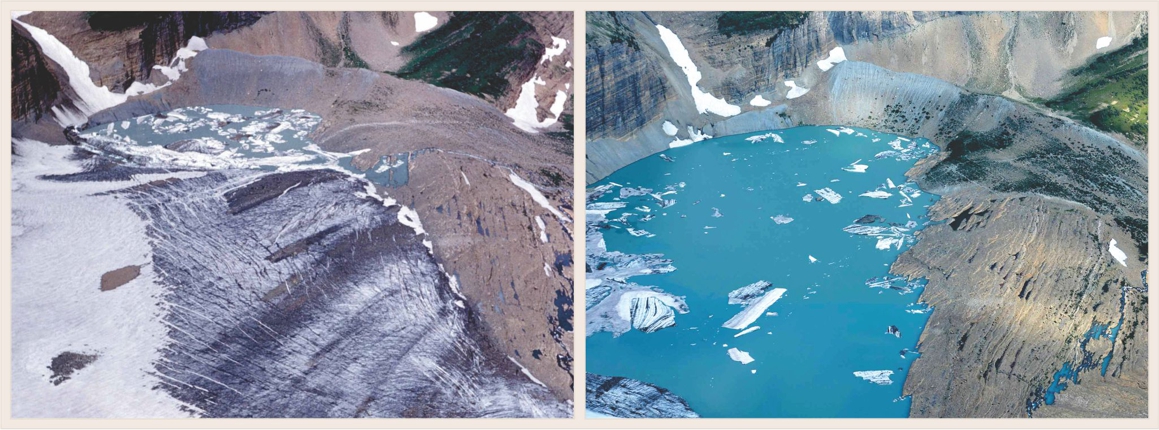Momentum grows for new climate agreement
DOI: 10.1063/PT.3.2777
Now that the US and Russia have pledged sizable reductions in their greenhouse gas emissions over the next 10–15 years, industrialized countries that spew 80% of the world’s pollutants have announced their commitments in advance of a new global agreement to slow climate change.

The retreat of the Grinnell glacier in Montana’s Glacier National Park is captured in these photographs taken in 1941 and 2013. According to some models, all of the park’s glaciers may disappear by 2030.
J. A. DONNAN, GLACIER NATIONAL PARK ARCHIVES. KEVIN JACKS, US GEOLOGICAL SURVEY

In its submission to the secretariat of the United Nations Framework Convention on Climate Change (UNFCCC) on 31 March, the Obama administration pledged to reduce US emissions of carbon dioxide and other greenhouse gases by 26–28% from 2005 levels by 2025. The next day, Russia promised to lower its emissions by 25–30% from 1990 levels by 2030. The UNFCCC is the parent treaty to the 1997 Kyoto Protocol and has 196 member states.
Neither China, the world’s largest greenhouse gas emitter, nor India, the third largest after the US, had submitted their pledges—so-called intended nationally determined contributions (INDCs)—by press time. But during President Obama’s November 2014 visit to Beijing, Chinese president Xi Jinping committed to begin curtailing that nation’s steadily increasing emissions in 2030.
The European Union’s 28 member nations have agreed to a binding reduction of 40% from 1990 levels by 2030. Mexico, Norway, Switzerland, and Gabon have also submitted INDCs. Industrialized countries that have yet to submit INDCs as of mid-April include Japan, Canada, Australia, and New Zealand.
The INDCs are a prelude to new climate change negotiations that are expected to wrap up in Paris in December. The goal of the Paris talks is to reduce the buildup of greenhouse gases sufficiently to prevent world temperatures from rising more than 2 °C from their pre-industrial levels. The initial INDCs “will clearly not add up to the emissions reductions needed” to meet that goal, said Christiana Figueres, executive secretary of the UNFCCC, “which is one reason why the Paris agreement must factor in a long-term emission trajectory based on science.” The new accord, to succeed the Kyoto pact, would take effect in 2020.
The path to steep cuts
“Our submission is ambitious and achievable within existing legal authority,” Brian Deese, Obama’s senior adviser on climate change, told reporters. The necessary regulations are already in place or will be by the time Obama leaves office, Deese said. Significantly tightened vehicle fuel economy standards by 2022 have already been passed. And an Environmental Protection Agency proposal known as the clean power plan, to become final this summer, mandates 30% cuts in carbon dioxide emissions from US power plants.
Still to come are regulations that will cut by nearly half the methane leakage from natural gas operations and landfills, and an international agreement on phasing out hydrofluorocarbons is in negotiation, Deese said. Both compounds are far more potent greenhouse gases than CO2.
The pledge “puts the US economy on track to reach deep reductions in greenhouse gas emissions, on the order of 80% by 2050,” he said, adding that post-2025 reductions would come from unspecified future technological advances and innovations.
Praise and scorn
Environmental groups welcomed the US pledge. “America’s leadership … already is delivering notable breakthroughs, such as the recent commitments by China and Mexico to join the global effort. And that bodes well for … the Paris conference in December,” said Rhea Suh, president of the Natural Resources Defense Council.
“This is a serious and achievable commitment,” said Jennifer Morgan, global director of the climate program at the World Resources Institute. “WRI research finds that under its existing federal authority, the United States can reach its proposed target.”
But some congressional Republicans vowed to fight the administration plan. “Even if the job-killing and likely illegal clean power plan were fully implemented, the United States could not meet the targets laid out in this proposed new plan,” Senate majority leader Mitch McConnell (R-KY) said. With 13 states having pledged to fight the plan, “our international partners should proceed with caution before entering into a binding, unattainable deal,” he said.
“There is a reason the president chose to bypass Congress in order to negotiate a climate deal on his own. The president’s plan gives control of US energy policy to unelected United Nations officials,” said House Science, Space, and Technology Committee chairman Lamar Smith (R-TX). “This plan ignores good science and only seeks to advance a partisan political agenda.”
Asked about congressional opposition, Todd Stern, US special envoy for climate negotiations, told reporters that “the kinds of regulations we’re putting in place do not get easily undone.”
More about the Authors
David Kramer. dkramer@aip.org
